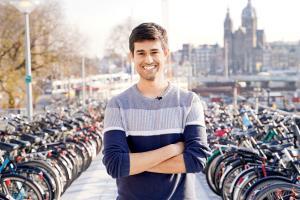YouTuber's Amsterdam visit leaves him in awe of the city's cycling infrastructure and solutions on how this can be replicated in India.

Dhruv Rathee, 25, shot the video two years ago, but posted it on January 1, 2020
On his visit to Amsterdam in the Netherlands in November 2019, Dhruv Rathee recorded, and later on, January 1 uploaded a 20-minute video on his YouTube channel. A week later, the clip garnered nearly nine lakh views. The numbers didn't matter to him. For, Rathee had already confessed on his social media account that this was "the best video" on his channel until then.
ADVERTISEMENT
It's saying quite a bit since this competes with 235 others that the 25-year-old has uploaded on the channel since its launch in 2015. Titled simply, Inside World's No. 1 Cycling City, the video is a ground report on how Amsterdam developed its infrastructure over the years to reduce the number of cars on streets. The clip begins with interesting detail, pointing at how the number of cycles in Amsterdam is equal to the population of the city—8,50,000.
He adds in the video, "About 19 per cent of the people living here [in Amsterdam] use cars. The area of the entire city is 200 square kilometers, and the cycling tracks laid down here are more than 400 square kilometers."
With over 2.92 million subscribers to his channel, Rathee—who moved from Delhi to Germany in 2011—is known for his thought-provoking videos that mostly discuss current affairs in India—from elections to violence inspired by religious intolerance. But, the Amsterdam video is special. "As a child, I loved cycling. Interestingly, it is a common activity in European countries. So, whenever I come down to India I wonder why can't we have infrastructure that makes commuting easy for people? This is why I chose this subject [for the video]," he adds.
In the video Rathee talks of how Amsterdam switched to being a cycle-proud city. "Between 1950 and 1960, there was an economic boom and cars had begun to become popular in Amsterdam. The government even began demolishing buildings to widen roads." But, the increased popularity of cars brought with it a rise in traffic accidents. "Around 1971, in just one year, more than 3,300 people were killed in road accidents in Amsterdam, of which 400 were children. That's when people started realising that the cars were detrimental for the city, and started the 'Stop de Kindermoord' (Stop Child Murders) movement," he explains. The oil crisis of 1973 made it difficult for people to afford motor vehicles and the government started encouraging people to use bicycles instead. As the years passed, a network of cycling tracks were built around the city. Taking us through the multi-decker underground parking facility for bikes in the video, Rathee says, "This model can be replicated in India."
Rathee lays down some solutions that would similarly help decongest Indian roads, reduce the number of accidents, and make commute simpler here. Speaking over the phone from Germany, he suggests restricting entry of cars, block by block. "In popular public spaces, we can start blocking the entry of cars. This way, slowly people will get used to using bikes. Eventually, we can replicate this model across entire cities." He says a similar experiment was tried in Delhi but failed. "Connaught Place is one of Delhi's most crowded spaces. However, the shopkeepers in the market complained that if the entry of cars is blocked, revenues would fall."
He adds that that usage of cycles would also reduce parking area needed—10 bikes can stand where one car took up space. "Research has shown that a car lane can be used by a maximum of 1,600 people per hour, whereas a cycling lane allows 7,500 people per hour." Of course, temperatures are better in Europe than in India and that often poses a hindrance. To this Rathee suggests, "We can use e-scooters or e-bikes. For that lesser effort is required."
Catch up on all the latest Mumbai news, crime news, current affairs, and also a complete guide on Mumbai from food to things to do and events across the city here. Also download the new mid-day Android and iOS apps to get latest updates
 Subscribe today by clicking the link and stay updated with the latest news!" Click here!
Subscribe today by clicking the link and stay updated with the latest news!" Click here!







